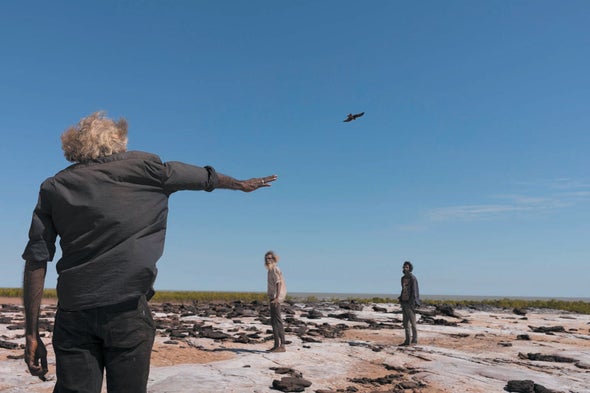In the early 20th century linguist Benjamin Lee Whorf thrilled his contemporaries by noting that the Hopi language, spoken by Native American people in what is now Arizona, had no words or grammatical elements to represent time. Whorf argued that this meant Hopi speakers had no concept of time and experienced what an English speaker might call “the passage of time” in a completely different way. This bold idea challenged the prevailing notion that there was a correct way to see the world—a way that lined up with the concepts already embedded in the languages of Western scholarship.
As it turns out, Hopi has quite a complex system for describing time, and those who speak it are perfectly capable of thinking about time in all kinds of ways, as indeed are all humans. In light of this realization, modern linguists assumed that even if the fundamental structures of language may differ—and even if languages specify things such as gender, number, direction and relative time in diverse ways—everyone must perceive the world in the same basic way.
Work on Australian Aboriginal languages has complicated that view, most recently in a groundbreaking study of Murrinhpatha. Spoken by most residents of Wadeye, a town of 2,500 people on Australia's northwestern coast, the language has many fascinating characteristics. Action, participants, ownership and intention may be expressed with a single word. This quality, which linguists describe as “polysynthetic,” means that many affixes may attach to a verb—and with each additional affix another layer of story accrues. The meaning conveyed by such a word contains actors and acting entwined into a complex whole. For example, the single word mengankumayerlurlngimekardi means “he was going through our bags stealing from us.
Murrinhpatha also has free word order, which means subjects, verbs and objects can and do occur in any position in a sentence. In practice, this means the two-year-olds of Wadeye learn how to wield massively complex words that bear little relation to the content of a typical English-language book of ABCs.
Recently Rachel Nordlinger, a linguist at the University of Melbourne who has studied Murrinhpatha for 18 years, and her colleagues conducted the first psycholinguistic experiment in the language. Significantly, they found that when people are putting their thoughts into words, their mental processes may be shaped by the structure of their language.
From the late 1950s onward one of the most important observations in modern linguistics was that any child can learn any language. It followed that all children must have the same mental equipment for acquiring language. In 2009 psycholinguist Anne Cutler observed that, in part because of this truism, researchers assumed the systems for adult language processing were also the same and would yield similar results across studies no matter what language they used to test them. Language-processing experiments were written up, replicated and discussed with no consideration of the fact that the different languages used may have had some effect on the findings. It wasn't that language diversity was entirely invisible, Cutler noted, but that the research objective was to unearth a universal system that all humans used.
Over time that view became less tenable, in part because of Cutler's contributions. One of her findings was that listeners segment a speech stream based on the cadence of their first language. French speakers segment a speech stream into syllables, whereas English speakers segment it by stress placement.
Field linguists, whose work brings them regularly into contact with the stunning diversity of the world's languages, also have long doubted the idea that a person's native language has no impact on their thought processes. And more recently, many researchers have been troubled by the fact that most work on universal properties of language and language processing has been carried out using English and a few other familiar languages—a group that probably represents less than 5 percent of the world's language diversity. “The focus was on finding universals and explaining away the differences,” says psycholinguist Evan Kidd, one of Nordlinger's co-experimenters. “But the search for universals took place in only one corner of the language universe.”
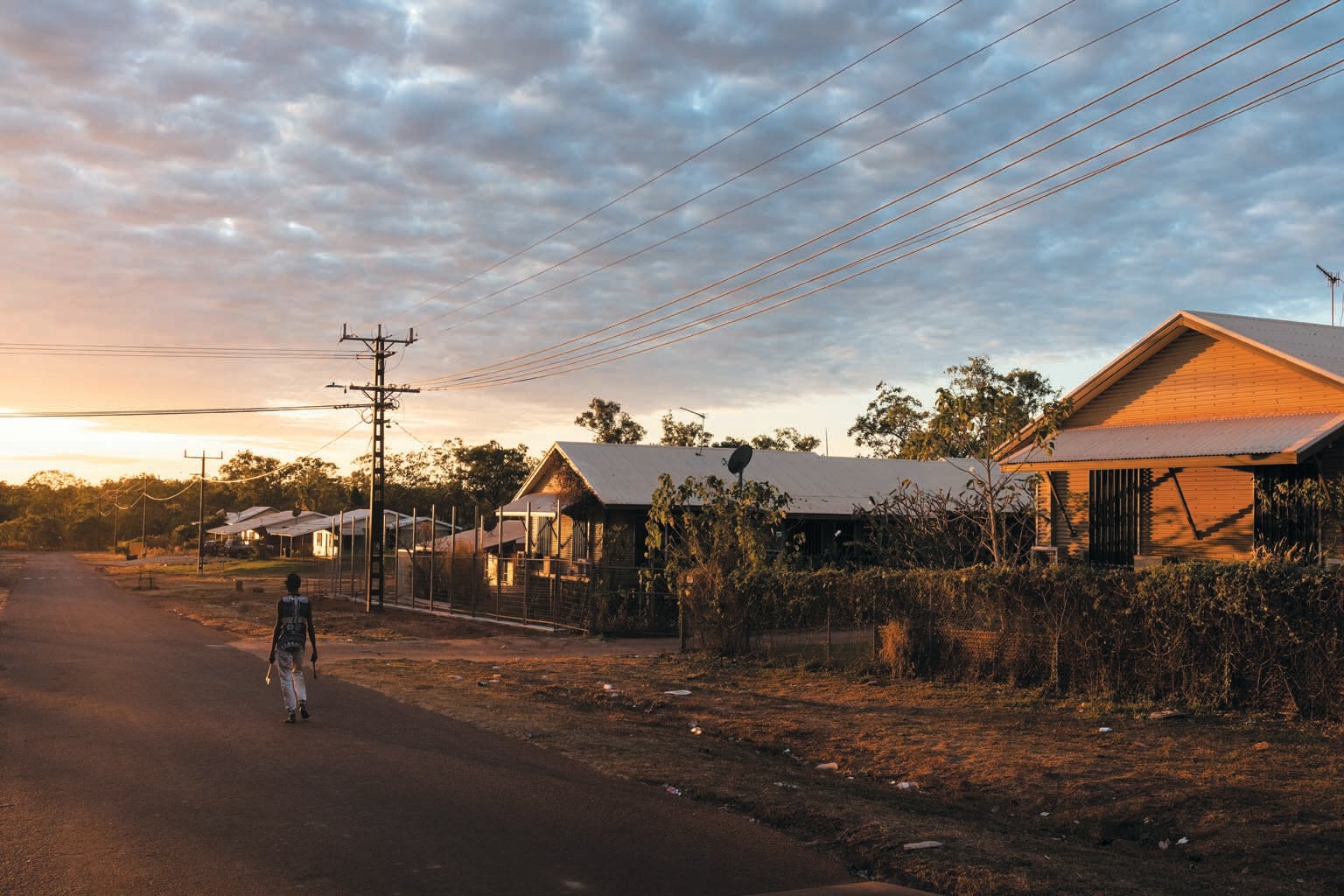
Australian languages are among the least explored by psycholinguists—a major gap given the size of the language family. Just 200 years ago at least 300 languages were spoken by people in Australia. Of that enormous group of languages, most belonged to the Pama-Nyungan family, with dozens of branches that descended from a protolanguage probably spoken 6,000 years ago in the northeastern part of the continent. Since colonization began in Australia in 1788, the number of Aboriginal languages still spoken in Indigenous homes in the country has been roughly halved. Of those remaining, only 13 are learned as a first language by children. Murrinhpatha, part of the relatively small group of non-Pama-Nyungan languages, is one of these 13—forming an unbroken thread of dynamic cultural inheritance that extends back many thousands of years. The language's survival is nothing short of astonishing.
Wadeye was first established as a mission in 1935, and many local Indigenous people there experienced forced assimilation. Children were taken from their families and incarcerated in a boarding school, where they were punished, sometimes sadistically, if they spoke their language. In many places where people experienced similar abuse, the local languages did not survive.
Moreover, the Wadeye mission brought together Indigenous Australians from 10 other language groups, but those languages did not survive in the same way. Now only a few elderly speakers who know them remain. But the children in Wadeye, Nordlinger says, speak Murrinhpatha. She once asked an elder, her friend and language consultant, how it was that despite the cruelty of the missions and the punishment by the nuns, her people still spoke Murrinhpatha. “We just used to whisper,” the woman replied.
Margaret Perdjert, 61, and Stephen Bunduck, 41, elders and residents of Wadeye, learned Murrinhpatha from their elders and later learned English in school. As speakers of both languages, they find that the two have different uses. English is good for talking to outsiders, and it helps kids in the community find good jobs. But their culture and their worldview are completely embedded inside Murrinhpatha, and, they add, the language is vital for their community. In fact, the number of Murrinhpatha speakers who learn it as a first language is growing. It has become the lingua franca of many local Indigenous groups, all with distinctly different language histories.
Nordlinger, who has been working with Murrinhpatha since 2005 but says she speaks it like a three-year-old, long suspected that understanding the demands the language puts on its learners could open windows on human thought. As director of the University of Melbourne's Research Unit for Indigenous Language, she leads the biggest team of researchers devoted to both studying Australian languages and supporting Indigenous speakers in their language goals. For Nordlinger, each language represents a unique expression of the human experience and contains irreplaceable knowledge about the planet and people, holding within it the traces of thousands of speakers past. Each language also presents an opportunity to explore the dynamic interplay between a speaker's mind and the structures of language.
In 2015 Nordlinger and Kidd attended a talk about using eye-tracking technology in language experiments, presented by psycholinguist Stephen C. Levinson, now director emeritus of language and cognition at the Max Planck Institute for Psycholinguistics in the Netherlands. The studies Levinson described demonstrated a clear relation between the grammar of a participant's language—specifically, the way words were ordered in it—and the way the person assessed a picture. For example, with a picture of a woman washing a child, English speakers, who perceived the woman as the subject, tended to look at the woman first. “The thinking,” Nordlinger says, “is that English speakers zoom in on the thing that they will express as their subject.” So English-speaking participants focused on the woman and started speaking. Then they looked at the rest of the picture and finished the sentence. “This all happens in milliseconds,” Nordlinger says.
Tseltal speakers did it differently. The grammar of Tseltal, spoken in Chiapas, Mexico, obliges speakers to produce a verb first. So when a group from Levinson's laboratory used eye tracking to understand sentence planning and production in Tseltal, the researchers found that speakers viewed the woman and the child more evenly, looking back and forth between the two. Psycholinguists call this relational encoding. “It makes sense,” Nordlinger says. “If you have to produce the verb first, you have to look across the picture, work out what's going on and assess it.”
At the talk Nordlinger asked Levinson what would happen if participants spoke a language with free word order. “We have no idea,” Levinson said. Kidd, who was sitting next to Nordlinger, whispered, “We should do that!

The obvious candidate was Murrinhpatha, which Nordlinger had been studying for a decade. But it took some planning to take a lab-based experimental method that closely tracks participants' utterances and eye movements and apply it to a language that had never been studied in that way before.
Finding a quiet space in Wadeye was step one. The first time Nordlinger ran the experiment she used a room in what is now a museum, although it was once a morgue. On other trips Nordlinger and Kidd used their rented lodgings in the town's old nurses' quarters—three units made from gray breeze-block, joined together. They used many of the same pictures as Levinson, adapting some to make more contextual sense: replacing deer with kangaroos, giving some people darker skin, and taking out anomalous objects such as a horse and a carriage.
The researchers also worried about how the conditions of the experiment might affect the outcomes. Murrinhpatha has free word order, but Nordlinger and Kidd didn't know whether certain situations—such as being asked to sit in a room and look at a series of pictures—might induce people to put the same elements in the same order. They kept their instructions minimal so as not to cue people to use one order over another, and they ran the study with 46 Murrinhpatha speakers.
The experimenters showed pictures of an event—a woman washing a child, a crocodile about to bite a man, a kangaroo punching a cow—on a laptop screen and asked the participants to describe what they saw. Before each picture appeared, the speakers were asked to look at a black dot that appeared randomly in the center or to one side of the screen so they wouldn't be inadvertently focused on any character. Then a short tone played, and the picture appeared. As participants assessed the scene and spoke, an infrared tracker that sat below the screen recorded their eye movements.
The results were stunning. The Murrinhpatha speakers did something completely new. It was like Tseltal, Nordlinger says, in that the speakers were looking evenly across both characters in a scene, but the Murrinhpatha speakers were doing it much faster and much earlier. It was very rapid relational encoding. “What's amazing,” Nordlinger says, “is that they were doing so much in the first 600 milliseconds.”
In that initial window the Murrinhpatha speakers were looking evenly back and forth across both characters in the scene, getting a sense of the entire event. Then, once they had decided which word order they were going to use, they started to look primarily at the character they mentioned first. At that point a person who produced a sentence that started with, say, the woman instead of the child spent more time looking at the woman. If instead they produced a sentence that started with the child, they spent more time looking at the child. Essentially, Nordlinger explains, “what a speaker looked at first in a sustained way after the initial 400-millisecond window was the thing that they mentioned first.”
The outcome was not a matter of a speaker simply mentioning the first thing their eye fell on. Sometimes speakers first looked at one of the figures in the picture but then spent sustained time looking at the other figure—and it was the second figure who featured as the first element of their sentence.
The researchers also found that every individual Murrinhpatha speaker had, on average, more than five and a half different ways of ordering the subject, verb and object of a sentence. Nordlinger had always argued that many Australian languages had free word order, unlike other languages. German, she says, is often described as having free word order, but when the same experiment was run in German by another researcher, speakers used the same order more than 75 percent of the time. For the Murrinhpatha speakers, word order was truly free. Across the entire set of possible responses, the Murrinhpatha speakers produced 10 possible word orders. There was no preferred order.
For example, in response to a picture of a falling man whose outstretched leg projects toward the gaping jaws of a crocodile—a picture where, essentially, a crocodile is about to bite a man—Murrinhpatha speakers offered the following sentences:
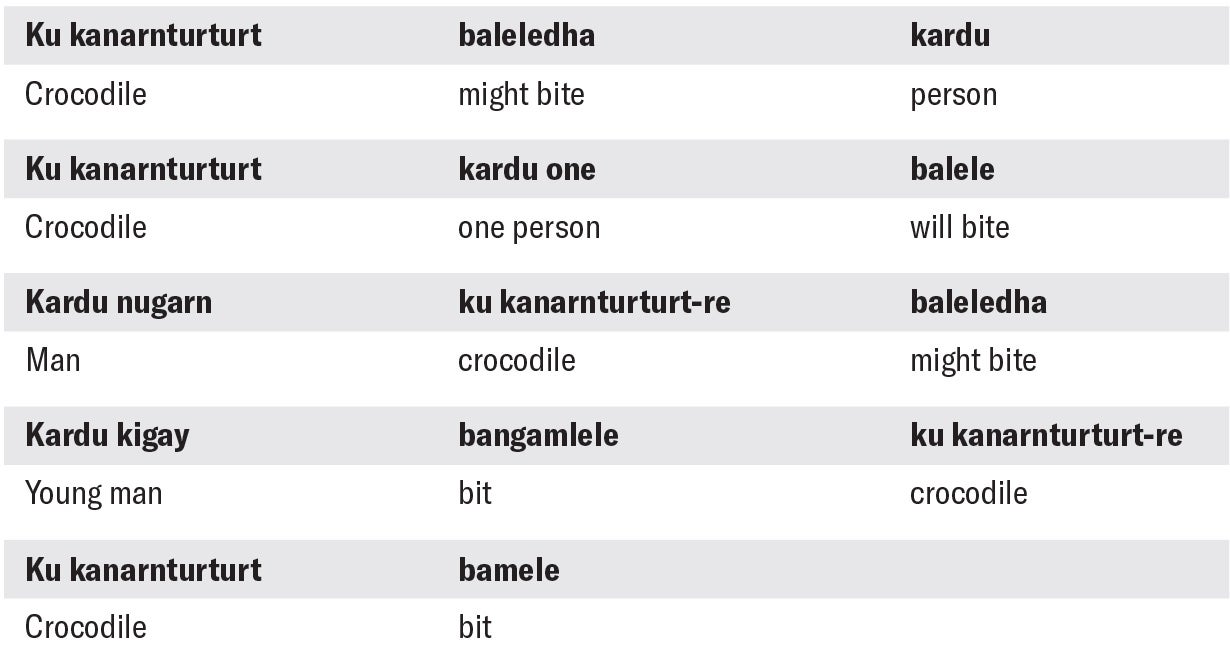
Why did Murrinhpatha speakers bounce back and forth between subject and object faster than the speakers of any other language? Nordlinger and Kidd suspect that when someone speaks a language that has a truly free word order, they are under pressure to swiftly make decisions about the sentence they will say. “You have to get your head around the whole event much earlier so that you can decide how you want to express it,” Nordlinger says.
Did Murrinhpatha's polysynthetic verb structure affect the pattern of language processing? To answer this question, Sasha Wilmoth, who was then one of Nordlinger's Ph.D. students, ran the experiment with speakers of Pitjantjatjara. The language is spoken by people in the Anangu Pitjantjatjara Yankunytjatjara lands, where South Australia abuts the Northern Territory. Pitjantjatjara also has free word order, but unlike Murrinhpatha, the language is not polysynthetic. Excitingly, Wilmoth got the same results.
The Pitjantjatjara speakers spent the first 600 milliseconds rapidly shifting back and forth between the two characters in the depicted scene and then started to focus primarily on the character that became the first element of their sentence. And like the Murrinhpatha speakers, the Pitjantjatjara speakers used a range of word orders, with each individual speaker using multiple word orders across the collection of pictures and the entire group using all the possibilities.
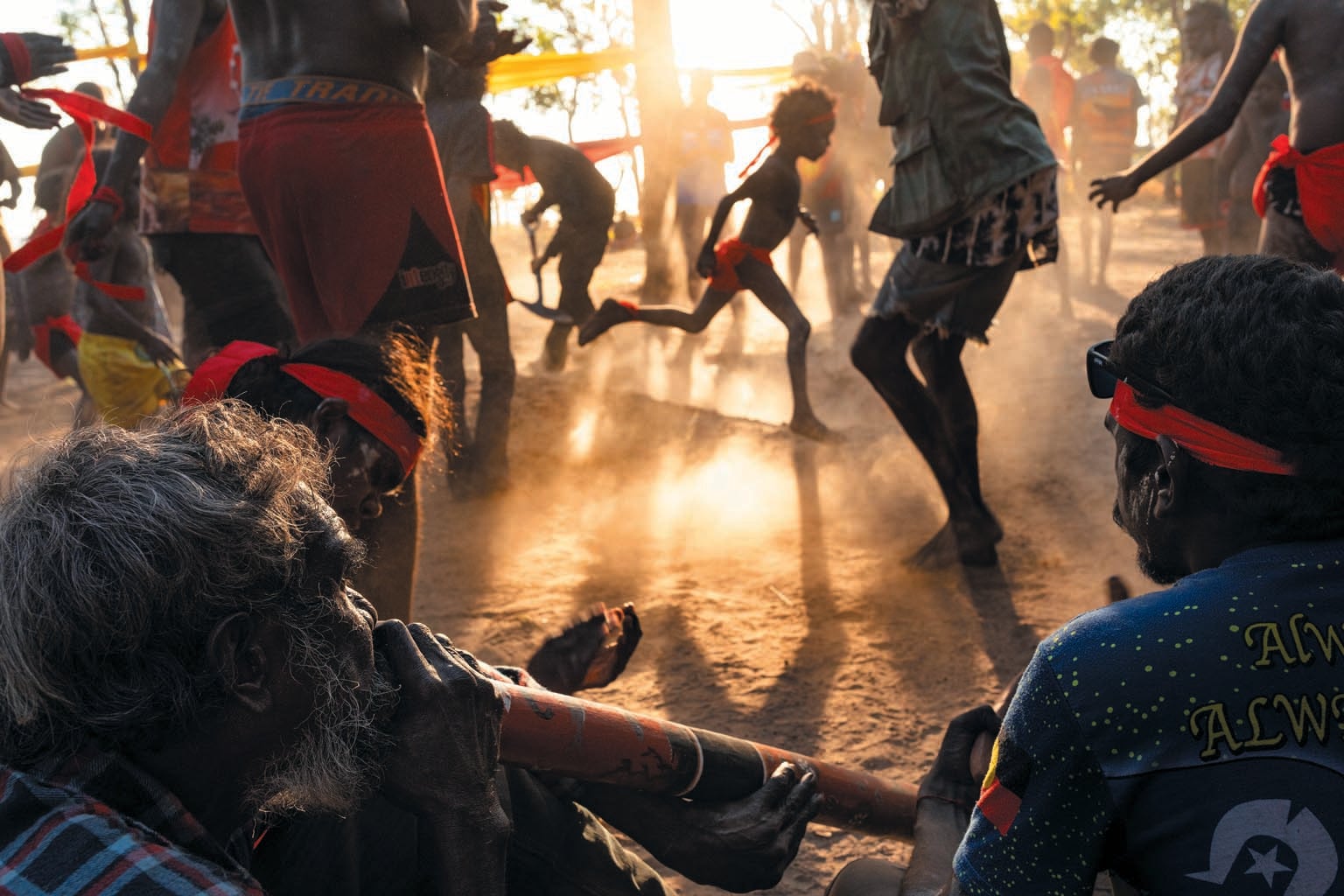
All human brains are of course the same, Nordlinger emphasized. But when people are putting thoughts into words, their mental processes may be different, depending on the language they are using.
To be fair to Whorf, even if his claims about Hopi were incorrect, there was significant merit in the questions he posed. Nordlinger and her colleagues focused on the impact of free word order at a critical moment in forming a sentence. Yet sentence structure is only one aspect of the complex, multipart system that is language. The question of how much language may influence thought should in fact be many questions.
Gary Lupyan, a psychology professor at the University of Wisconsin–Madison, says that words can organize the way we think about the world and shape the way we perceive it. In a recent experiment, he and his colleagues measured how hard it was for English speakers to assign circles colored in diverse ways to a random category (such as “A” or “B”) if the colors were easy to name (for instance, “red” or “blue”) or hard to name (“slightly neutral lavender” or “light dusty rose”). All the colors, regardless of how nameable they were in English, were equally easy to discriminate visually from one another. Even so, Lupyan and his colleagues found strong differences in participants' ability to learn which circles went into the different categories based on how easily nameable the colors were.
The vocabularies of languages are “systems of categories,” Lupyan explains. “Language entrains us into these systems, one set of categories versus another.” For speakers of different languages, he says, “many of these categories then become entrenched as basic units of thought.” With Lera Boroditsky of the University of California, San Diego, a cognitive scientist who has long pursued these questions, Lupyan and others recently surveyed a large set of studies on the effects of language on visual perception. They found compelling evidence that language influences our ability to discriminate colors.
For Murrinhpatha, beyond the window that Nordlinger, Kidd and their colleagues have opened on how the language is produced, we cannot say without rigorous research how individual speakers' perception might be further shaped by their language. Yet we can clearly see, Nordlinger says, that over time the culture has shaped the structure of the language. “Kinship has central importance in Murrinhpatha culture, and we see that encoded in the grammatical structure,” she explains. “When you're talking about a group of people in Murrinhpatha, you have to inflect the verb according to whether the people are related as siblings or not.”

Similarly, Murrinhpatha divides all nouns into 10 different classes. Nordlinger asks her students what 10 categories they would use if they were going to divide up all the objects in their language. (English doesn't have categories of nouns that are grammatically differentiated.) The Murrinhpatha noun classes are: familiar humans; all other animate beings; vegetables and other plant-based foods; language and knowledge; water; place and time; spears (used for hunting and ceremonies); weapons; inanimate things; and fire. Things become grammatical, Nordlinger notes, when people talk about them a lot.
Culture shapes language because what matters to a culture often becomes embedded in its language, sometimes as words and sometimes codified in its grammar. Yet it is also true that in varying ways a language may shape the attention and thoughts of its speakers. Language and culture form a feedback loop, or rather they form many, many feedback loops.
At one level, of course, we already understand this reasoning. Over the minutes and days of our lives, we see how perception and judgment and words wind together and influence one another. But as Nordlinger, Lupyan and their colleagues show, some of those loops form tight millisecond whorls that tie together our instantaneous perception of the world and our habitual way of framing it in words. There are much larger interconnected loops, too, that bind speakers throughout history. The things distant generations discussed may shape the structure of a speaker's language today, and that in turn may influence at the micro level how that speaker assesses the world and produces words to describe it.
To Perdjert, the language comes first—because that is how she and other elders pass on sacred knowledge to their young people. But language, culture and knowledge are actually forever entwined and integral to one another. Murrinhpatha, she and Bunduck explain to me, is translated as “Murrinh,” meaning “language,” and “patha,” meaning “good”: good language. “Strong language,” Perdjert says.
What's clear now is that the more we ask empirical questions about language and its many loops in all the world's languages, the more we will know about the diverse ways there are to think like a human.
Even as researchers devise ways to explore all the corners of the language universe, it is shrinking at a frightening rate. The Language Conservancy, a nonprofit organization founded by Indigenous educators and activists in the U.S., estimates that 61 percent of languages around the world that were spoken as a first language in 1795 “are doomed or extinct.” Early in Nordlinger's career, when she worked with a community that spoke Wambaya, another non-Pama-Nyungan language used in the Barkly Tablelands of Australia's Northern Territory, the elders requested that the work be done so younger generations would have a chance to learn the language of their ancestors. At the time there were eight or 10 fluent speakers remaining. All have since died.
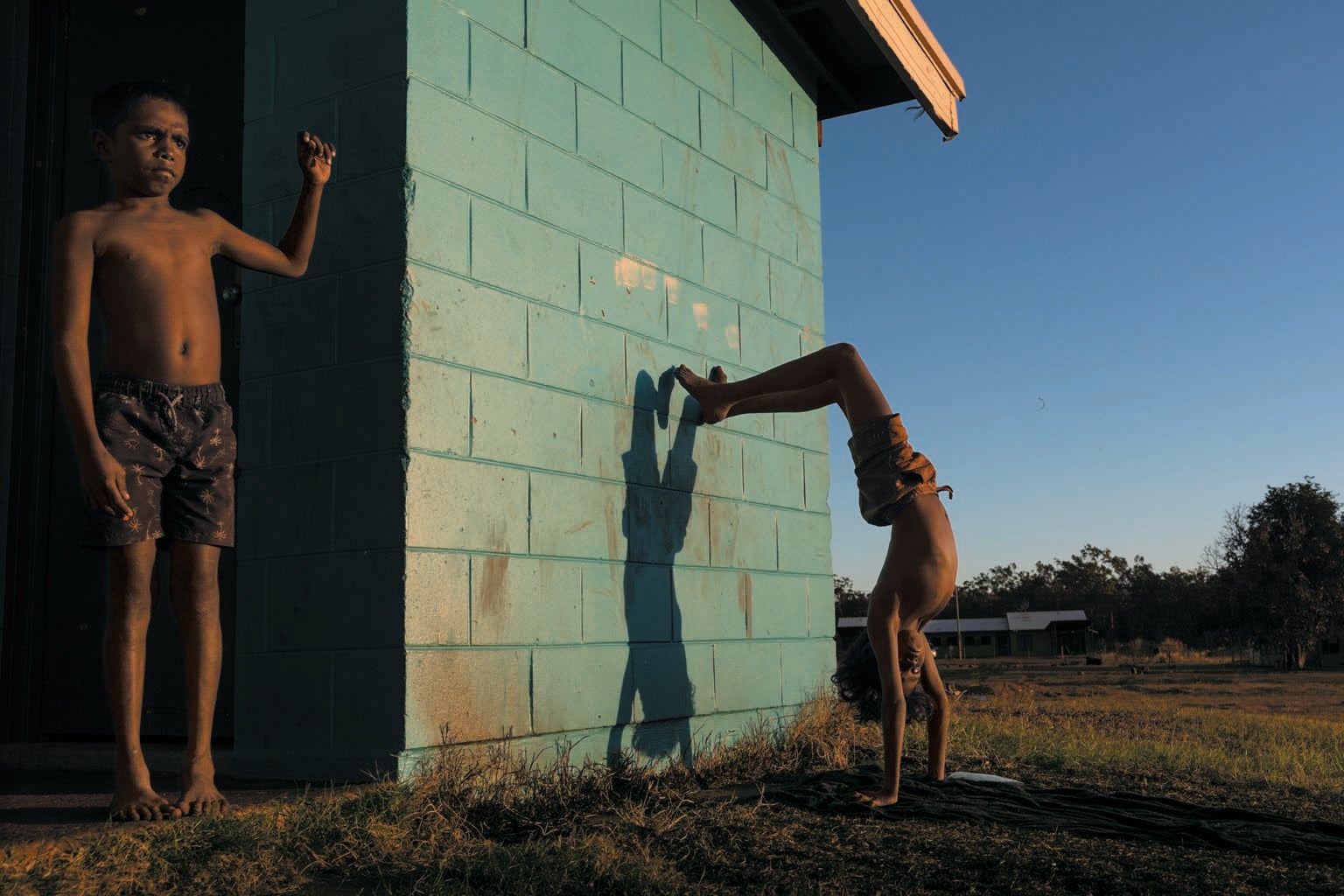
A deeper understanding of Murrinhpatha may help here, too. As with other Australian language communities, there are many Indigenous-guided efforts to maintain the language. Linguists and educators, including Nordlinger, work with the people of Wadeye to support their learning goals and to contribute to a constantly evolving understanding of the language.
Scholars at the Research Unit for Indigenous Language have studied how children first acquire Murrinhpatha, with a view to informing how the language is taught in school. They have worked with Perdjert and other elders to run Murrinhpatha literacy programs in a Darwin prison and have explored how children tell stories in Murrinhpatha. They have tracked how the language has changed over three generations, finding that its grammar has not been influenced by English, although—as all languages do—it has changed in that time. The Literature Production Center at the Wadeye community school works with locals to produce bilingual curriculum materials to support children's Murrinhpatha literacy as much as their English literacy. Being able to read and write Murrinhpatha as well as speak it gives the children confidence, Perdjert says.
But even before the children get to school, Perdjert and Bunduck explain, elders take them out to the bush and sit with them around a fire to “teach them in language.” They describe the natural world and tell stories from the dreaming about the beings that created their world. Bunduck also teaches the songlines, stories in ceremonial song that include sacred sites and the routes ancient beings took across the land. When Bunduck learned the songlines from his grandparents, it was a gift they gave him, he says. Now he passes on the songlines to youths in the next generation, giving that gift to them.
